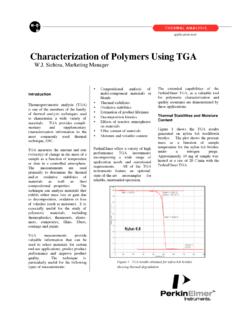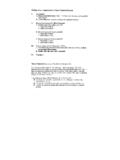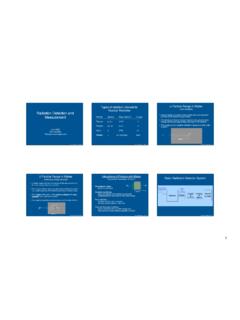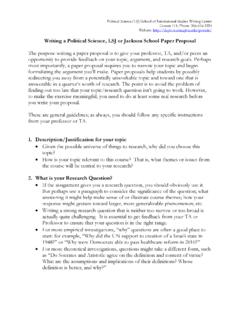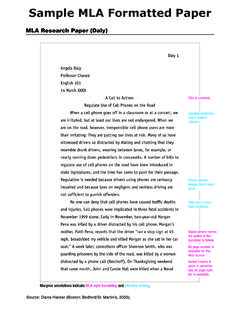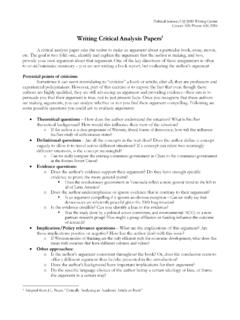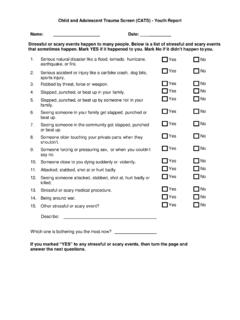Transcription of Physical growth and development during adolescence
1 Physical growth and development during adolescence Kym Ahrens, MD, MPH Assistant Professor, Adolescent Medicine UW/Seattle Children s Definitions Adrenarche = activation of the adrenal cortex produce adrenal androgens (typically occurs before the onset of puberty). Gonadarche = activation of the gonads by the pituitary hormones follicle-stimulating hormone (FSH) and luteinizing hormone (LH) Pubarche = appearance of pubic hair Thelarche = appearance of breast tissue Menarche = age of onset of the first menstrual period Spermarche = age at first ejaculation (heralded by nocturnal sperm emissions and appearance of sperm in the urine) Features of Puberty Physical change reflects hormonal change Order of changes similar for both sexes Onset: Girls: 7 to 13 years* Boys: 9 to 14 years Timing and rate: ~ 5 years females; ~6 years males Differs by gender & ethnicity Length of puberty Boys: 4-6 years (mean ) Girls: 3-4 years Trigger for puberty?
2 Not clear probably 50-80% of variation in onset = genetics Change in body composition = permissive role (Leptin) A threshold percentage of body fat in likely necessary but not sufficient for onset ( Leptin LH pulse pubertal suppression) The Start of Puberty Body Clocks controlled by master genes ? Inhibitory central feedback maybe mediated by GABA nergic or neuropeptide Y-secreting neurons GnRH pulse generator becomes increasingly active, first nocturnally then during day Hormones of Puberty H-P-G Axis Adrenal system HPG Axis: Fetus/Infancy In the fetus: GnRH, gonadotropins and gonadal steroids present at 10 weeks gestation At birth, placental sex steroids decrease, leading to a rise in pulsatile release of gonadotropins and hence of gonadal steroids during infancy H G - P - HPG Axis: Childhood Low levels of sex steroids exert powerful negative feedback on the hypothalamus, suppressing gonadotropin release In addition, the CNS exerts a separate inhibitory effect on hypothalamic secretion of GnRH G - CNS P H - H G CNS P HPG Axis.
3 Puberty Onset Disinhibition of the GnRH neurons by the CNS leads to pulsatile release of GnRH sensitivity of H to gonadal steroids leads to LH/FSH secretion. Increased LH and FSH lead to testosterone and estrogen. LH/FSH LH FSH MALES Testosterone production Leydig cells Sperm production Sertoli cells FEMALES Androgen production theca cells Progesterone production corpus luteum Mid-cycle surge ovulation Ovarian follicle dev Estrogen production granulosa cells Testosterone TESTOSTERONE MALES growth of penis and scrotum growth of pubic/facial hair Deepening of voice Increased libido Increased muscle mass Acne Thickening of cortical bone FEMALES Thickening of cortical bone growth of pubic hair Estrogen ESTROGEN MALES peripheral conversion Important bone effects: Low levels: pubertal growth spurt, accrual of peak bone mass Higher levels.
4 Closure of the epiphyses FEMALES Bone effects as in males growth of breasts, labia, vagina, uterus Pattern of fat deposition Vaginal pH and vaginal length Proliferation of the endometrium Triggers LH surge Adrenal System Adrenarche: Secretion of adrenal steroids from the zona reticularis of the adrenal gland cortex Typicaly precedes in gonadal steroids by 2yrs Independent of HPG axis Trigger unknown Effects: Pubic/axillary hair, body odor, acne Conversion in body DHEA DHEAS Androstinedione Estrone Testosterone Pubertal Timing Sequence is predictable Timing is highly variable Chronological age correlates poorly with biological maturity Best to assess maturity by tanner staging or skeletal age/bone age Often asynchrony between breast/genitalia and pubic hair slight lag in HPA axis Jeff: Tanner stage V Pete: Tanner stage II Too early, too late Breast Changes: Early<7 in girls Late>13 in girls Pubic Hair: Early<7 in girls Late>13 in girls Menarche: Too late>16 (or > 5 yrs from TS-II breasts) Gonad changes: Early <9 in boys Late >14 in boys Pubic Hair: Early <9 in boys Late >15 in boys Duration of Puberty.
5 Too long>5 yrs from TS II-V Early Puberty Higher self-esteem Greater social approval Earlier onset sexual behavior More body dissatisfaction Lower self esteem Earlier onset sexual behavior Puberty Getting Earlier? Menarche: 1850s 1950s - mean age of menarche from 17 yrs <14 yrs in Europe Timing of menarche relatively stable since 1960s in Breast development : ? since the 1970s in the United States: 1970s : age 8 1997 : age 7 (white girls) and age 6 (African Am girls) ? Due to changes in nutritional, health, & SES, other causes?. Physical growth : Rate Average normal growth velocities: 1st year 25 cm/yr 2nd year 10 cm/yr 3rd year 8 cm/yr 4th year 7 cm/yr 5th to 10th year 5 cm/yr Puberty 8-10 cm/yr Body Composition The Perils of Clinical Question: A 14yo male comes into your office.
6 You detect upon walking into the room that he needs to start wearing deodorant. You also note that he has some mild facial acne and some axillary hair. Should you conclude that he is going through puberty normally? Which system causes these changes? Answer: Not necessarily. These are all signs that his adrenal system is producing hormones, but does not tell you anything about the H-P-G axis. Acne Usually normal BUT can be a source of low self-esteem Caused by the _____ _____ Severe acne + other signs/symptoms of androgen excess: Acne Usually normal BUT can be a source of low self-esteem Caused by the adrenal system Severe acne + other signs/symptoms of androgen excess: Consider endocrine disorder, NON-CLASSIC CONGENITAL ADRENAL HYPERPLASIA Clinical Question: A 12 yo male presents with pain and swelling in his right nipple.
7 What do you want to know? What can you tell him about this condition? Answer: What you want to know: Is puberty progressing normally? Is he on any medications? Any chronic illnesses? Gynecomastia Glandular development due to changes in hormone levels during puberty (estrogenic-androgenic balance) 1/3 of healthy guys Usually resolves in 3-24 months without intervention. Assessment/management: Careful history for common drug culprits or chronic diseases (liver dz) PE to assess for true vs. pseudogynecomastia Monitor every 3-6 months until resolved Consider SERM, surgical referral if: Lasts longer than 12 mos, causing discomfort/embarrassment, AND adult testicular size has been attained Drugs & Gynecomastia Common culprits in adolescents: Drugs of abuse (alcohol, amphetamines, heroin, marijuana, anabolic steroids) Psychoactive drugs (antipsychotics) Reflux meds (ranitidine, cimetidine, omeprazole) Antifungals/antibiotics (metronidazole, ketoconazole, INH) Clinical Question: An 11 year old soccer playing female comes into your office for a sports Physical .
8 Name 2 common musculoskeletal complaints that occur in adolescence and are impacted by skeletal maturity. Answer Osgood Schlatter: Caused by overuse chronic avulsion of tibial tubercle growth plate Usually happens in athletic adolescents right after growth spurt ( , age 13-14 in boys, age 11-12 in girls) Clinical diagnosis: appropriate history, tibial tubercle swelling Scoliosis: 80-85% adolescent onset Progression more common in girls once diagnosed Once skeletal maturity occurs, will not progress Indications for referral to an orthopedic surgeon Angle of trunk rotation (as measured with the scoliometer) of 7 , Cobb angle 20 , and progression of Cobb angle of >5 . Clinical Question: This 16 yo female with scoliosis asks you if you think her curve will get any worse.
9 What do you need to know? Answer: You want to know her Tanner Staging and when she had menarche. Since she is TS V, and had menarche 4 years ago, she probably will not be growing much more and her curve should not increase. Other common issues Anemia (9% of adolescent girls = iron deficient) Myopia (caused by growth in axial diameter of the eye) Dysfunctional uterine bleeding (80% due to anovulation) STIs (peak incidence of many STIs 15-24 years) Our favorite puberty books American Medical Association Girl s Guide to Becoming a Teen (Kate Gruenwald & Amy B. Middleman) also boy version What's Happening to me? (Peter Mayle) Where Did I Come From? (Peter Mayle) Will Puberty Last My Whole Life? (Julie Metzger &Rob Lehman) American Girl s The Care and Keeping of You (Valorie Schaefer & Norm Bendell) THANKS!
10 !!! David Breland Ann Giesel

